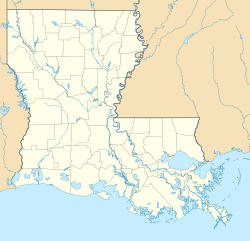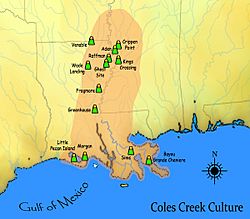Morgan Mounds facts for kids
| Location | Pecan Island, Louisiana |
|---|---|
| Region | Vermilion Parish, Louisiana |
| Coordinates | 29°38′50.82″N 92°26′7.656″W / 29.6474500°N 92.43546000°W |
| History | |
| Founded | 700 CE |
| Abandoned | 1000 CE |
| Cultures | Coastal Coles Creek culture |
| Site notes | |
| Excavation dates | 1926, 1979, 1986 |
| Archaeologists | Henry B. Collins, Ian Brown, Richard Fuller, |
| Architecture | |
| Architectural styles | Platform mounds |
| Responsible body: private | |
The Morgan Mounds (also known as 16 VM 9) is a really important archaeological site in Louisiana. It was built and used by Native Americans from about 700 to 1000 CE. This site is found on Pecan Island in Vermilion Parish, Louisiana.
The people who lived here were part of the Coastal Coles Creek culture. Out of 45 known sites from this culture in the Petite Anse area, Morgan Mounds is special. It's the only one with large ceremonial mounds. This suggests it might have been a main center for a local group or "chiefdom."
Contents
Exploring the Morgan Mounds Site
This ancient site is located on a rare piece of high ground in a very marshy area. This high ground, Pecan Island, is a type of landform called a "chenier." Cheniers are old beach ridges that formed thousands of years ago. They were created when the Mississippi River delta shifted, leaving behind ancient beaches.
The area around the mounds was full of resources. There was plenty of food from the salty and fresh water marshes. The forests on the cheniers (named by French settlers for their oak trees, or "chênes") also provided many things. Most of the local people didn't live at the Morgan site all the time. They lived in smaller villages and homes nearby. You can often find their old homes by the shell middens (piles of discarded shells and other waste) they left behind.
What the Mounds Looked Like
The Morgan Mounds site originally had four large platform mounds. These mounds were built for ceremonies. They were placed around a central rectangular open space called a plaza.
The people built these mounds in different stages over a long time. There were breaks between each building phase. Before the mounds were even started, people lived in the area. We know this because archaeologists found a pre-mound midden (a trash heap) underneath. Later, residents built a mound over this area. They also built a separate structure on top of the mound.
Building these earth mounds was a clever engineering feat. The builders used loose sand and crushed shells from the chenier. They mixed this with topsoil from the midden. This mixture helped them create strong, rectangular walls. They then filled these walls with more sand and crushed shells. This method made the structures stable enough to last for over 1,000 years without falling apart. To protect the mound, they covered it with a layer of silty, gray clay from a nearby bayou.
Later, the people made Mound 1 even bigger and taller. It eventually reached more than 4 metres (13 ft) high. Another building was constructed on its new, higher top. This building was round, about 9 metres (30 ft) across. It had many inside walls and a large central fireplace. It was made of wooden posts set into the mound. The posts were covered with a layer of clay, making a strong building. Many post holes found at the site suggest these buildings were rebuilt several times.
Who Lived at Morgan Mounds?
The people who lived at Morgan Mounds were quite unique for their area. Before 700 CE, most local people were hunter-gatherers. They didn't build large settlements or ceremonial mounds. This was different from their northern neighbors, like the Troyville culture (400 to 700 CE).
Scientists studied the pottery found at the site. They found that while the Morgan Mounds people were part of the Coles Creek tradition, they also traded with others. They were more influenced by the Weeden Island cultures from the Gulf Coast and Florida. This was more so than by the Coles Creek people in northern Louisiana and Mississippi.
Archaeologists found workshops for making pottery at the site. They also found examples of special, high-quality pottery and other valuable items. By looking at the old trash heaps on and around the mounds, they learned something interesting. People who lived on top of the mounds had access to more and better food. This suggests they were important or "elite" members of the community.
Dr. Ian Brown, who dug at the site in 1986, wondered about the sudden appearance of mound building and new pottery styles. He thought it might mean new people moved into the area. Or, perhaps, they were inspired by ideas from outside the region. This idea is still being studied.
Discovering the Past: Excavations
The first archaeological digs at Morgan Mounds happened in 1926. Henry B. Collins, Jr., from the Smithsonian Institution, led these early efforts. He found different kinds of pottery and human burials. Some of the skulls showed signs of "artificial cranial deformation." This means their heads were shaped in a particular way.
Sadly, the southernmost mound, Mound 4, was flattened in the mid-1950s. This happened during the building of LA 82, a road. The site was surveyed again in 1979 by Dr. Ian Brown and Richard S. Fuller, Jr. They were working for the Peabody Museum of Archaeology and Ethnology.
In 1985, the landowner planned to level some of the mounds. But then, a special carving called the "Morgan effigy" was found in dirt from Mound 2. Because of this important discovery, emergency "salvage archaeology" was quickly done in 1986. Brown, Richard Fuller, and Diane Fuller led this important work.
The Morgan Effigy
The "Morgan effigy" is a carved deer antler figure. It was found in 1985 in dirt that the landowner had removed from one of the mounds. This small sculpture shows a human death figure in a unique artistic style. Bones were found in the same dirt, suggesting the effigy might have been buried with an important person.
This effigy is very special because it's the only known artwork from the Coles Creek culture that isn't made from pottery. You can see the Morgan effigy today at a permanent display at the Alliance Center in nearby Abbeville, Louisiana. A drawing of it is even used as the logo for the Vermilion Historical Society.
Nearby Ancient Sites
Other smaller sites in the area, without mounds, have also provided items from the Coastal Coles Creek period. In 1946, Robert Wauchope investigated the Little Pecan Island Site (16 CM 43). This site is near Grand Chenier, Louisiana in Cameron Parish. He found pottery that dates back to between 800 and 1100 CE. Several burials were also found at this site.



